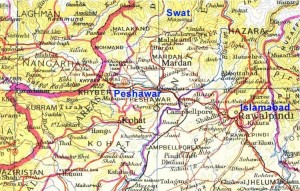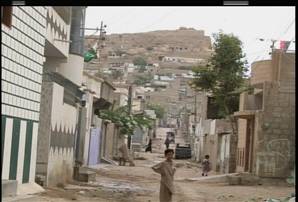Pakistan on the Brink of Collapse
BY Herschel SmithIn NATO and Pakistan Commitment to Defeat Taliban Wavering we discussed the deep ambivalence of the Pakistan parliament towards the fight against the Taliban. The parliament has little stomach for a protracted counterinsurgency against the Tehrik-i-Taliban. The problems with properly understanding the horrible danger they are in run deep, and so do the overall problems with Pakistani society, both culturally and financially. In fact, the country itself is on the brink of collapse and civil war.
Pakistan was locked in crisis last night, with the government pressed by Washington to deepen its conflict with Islamic militants in the lawless regions on the Afghan border, and obliged to call in the International Monetary Fund to stave off financial catastrophe.
In the rugged north of the country, a major military offensive to root out Taliban militants has created a flood of up to 200,000 refugees and pitched Pakistani against Pakistani, Muslim against Muslim, in a conflict some are beginning to regard as a civil war.
A new US intelligence estimate meanwhile has warned that the renewed insurgency, coupled with energy shortages and political infighting, means that Pakistan, which is the only Muslim nation with nuclear weapons, is “on the edge”.
“Pakistan is going through the worst crisis of its history,” according to a leaked letter signed by the former prime minister Nawaz Sharif, the main opposition leader. It is a view shared by Imran Khan, another opposition leader, who says that the political and economic meltdown “is leading to a sort of anarchy in Pakistan”.
“How does a country collapse?” the former cricketer asked. “There’s increasing uncertainty, economic meltdown, more people on the street, inflation rising between 25 and 30 per cent. Then there’s the rupee falling.”
Pakistan is experiencing power cuts that have led to hourly blackouts, a doubling of basic food prices and a currency that has lost a third of its value in the past year. “The awful thing is there’s no solution in sight – neither in the war on terror nor on the economic side,” Mr Khan said during a visit to London. Heightening the sense of national emergency, the government yesterday turned to the International Monetary Fund for $15bn (£9.3bn) to cope with a balance of payments crisis caused by a flight of capital, after previously saying that applying to the IMF would be a last resort.
Almost every day there are retaliatory attacks against police and soldiers and Western targets. Hundreds of soldiers and an unknown number of civilians are losing their lives. The national parliament rejected the US influence on the government by adopting a resolution last night calling for an “independent” foreign policy and urging dialogue with the extremists.
The Pakistanis with money have pulled their funds from banks and investments in Pakistan and moved them towards the Middle East. Pakistan is facing a liquidity crisis. In spite of the Taliban violence, claims of violence, globalist perspective and refusal to disarm, the Pakistani people still cling to the belief that there is something else behind the movement. The movement, they claim, wouldn’t be capable of surviving without the influence and support of foreign intelligence services.
It is not as worrying to see the Taliban running free in Pakistan. But it is more worrying to see our government and intelligence agencies running around confused without being able to figure out who are financing the Taliban. While every Pakistani even with half a mind knows that India with its 14 consulates on the Pakistan-Afghanistan is financing the Taliban. Now we can just hope that the government and media promote these facts to the International community and pressurize India to stop financing the Taliban.
The preoccupation with India and their alleged misdeeds and interest in the conquest of Pakistan claims not only the full attention of Pakistan military officers, but the common, ordinary citizens. The claims have become so prevalent that the Taliban saw them as requiring rebuttal.
Tehrik-e-Taliban Pakistan refuting allegations that they are destabilising Pakistan on the behest if foreign intelligence agencies has indicated that they are willing to lay down their arms if the government assures of an end to the ongoing military operation.
TTP spokesman Maulvi Omar talking to BBC said that there is no truth to news and such assertions are baseless that the Taliban movement is destabilising Pakistan on the say of foreign intelligence agency adding that we are stuck to our stance that if the government ends the military operation than we would lay down their arms. However, he added, that it is the government who always backs out on its promises.
He said that we have no foreign pressure and we are fully independent in making our own decisions.
Maulvi Omar claimed that the Taliban movement is very popular in the area and they would ceasefire when the tribesmen would wish them to do so.
NATO – and even U.S. military leadership – is looking for a magic solution, the silver bullet to kill the Taliban; a button to push, an incantation to chant. For now that incantation is to peel away layers of the reconcilables to fight against the hard core irreconcilable Taliban. The Pakistanis, almost all of them, want to negotiate and talk with the Taliban too. But they have added another layer of counterinsurgency to their stable of imaginary solutions. Get India to stop financing the Taliban.
You can’t make this sort of stuff up. Reality is sometimes more bizarre than fantasy. This is the same India who fought jihadist insurgents in Kashmir for more than a decade and had jihadist bombings in her cities. If the notion that Indian intelligence is funding the Taliban sounds ridiculous, its only because it is. But Pakistan is still stumbling in the darkness of ignorance to the danger she faces – this danger becoming more pronounced with each passing day. The time to save Pakistan is ebbing away, and yet she sits and points her finger at her neighbors.





